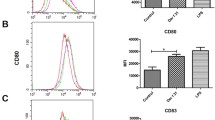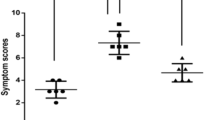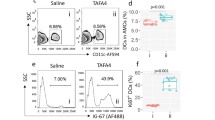Abstract
It has been proposed that activation of Toll-like receptors (TLRs) plays crucial roles in the polarization of adaptive immune responses. A synthetic Toll-like receptor 2 (TLR2) ligand, Pam3CSK4, has been reported to modulate the balance of Th1/Th2 responses. We evaluated the modulation effect of Pam3CSK4 on allergic immune response in a mouse rhinitis model sensitized to house dust mite allergen (HDM). Mice were sensitized and challenged with Dermatophagoides farinae allergen (Der f), and then the allergic mice were treated by Pam3CSK4. Nasal allergic symptoms and eosinophils were scored. Der f-specific cytokine responses were examined in the splenocytes and bronchoalveolar lavage fluid (BALF). Serum level of total IgE was also detected. After establishing a mouse allergic rhinitis model with HDM, we have showed that Pam3CSK4 treatment not only ameliorated the nasal allergic symptoms remarkably but also decreased the eosinophils and total inflammation cells in BALF significantly. Analysis of cytokine profile found that IFN-γ released from either BALF or stimulated splenocytes increased markedly in Pam3CSK4-treated mice, while IL-13 decreased significantly. Moreover, serum level of total IgE was significantly lower in Pam3CSK4-treated mice than in the untreated. Thus, in an allergic rhinitis mouse model developed with HDM, Pam3CSK4 was shown to exhibit an antiallergic effect, indicating its potential application in allergic diseases.
Similar content being viewed by others
References
Agrawal, S., Agrawal, A., Doughty, B., Gerwitz, A., Blenis, J., van Dyke, T., Pulendran, B., 2003. Cutting edge: different Toll-like receptor agonists instruct dendritic cells to induce distinct Th responses via differential modulation of extracellular signal-regulated kinase-mitogen-activated protein kinase and c-Fos. J. Immunol., 171(10):4984–4989.
Akdis, C.A., Kussebi, F., Pulendran, B., Akdis, M., Lauener, R.P., Schmidt-Weber, C.B., Klunker, S., Isitmangil, G., Hansjee, N., Wynn, T.A., et al., 2003. Inhibition of T helper 2-type responses, IgE production and eosinophilia by synthetic lipopeptides. Eur. J. Immunol., 33(10): 2717–2726. [doi:10.1002/eji.200323329]
Akiba, H., Mitsuishi, K., Ikeda, S., Okumura, K., Ogawa, H., 2006. Crucial commitment of proteolytic activity of a purified recombinant major house dust mite allergen Der p1 to sensitization toward IgE and IgG responses. J. Immunol., 177(3):1609–1617.
Berin, M.C., Zheng, Y., Domaradzki, M., Li, X.M., Sampson, H.A., 2006. Role of TLR4 in allergic sensitization to food proteins in mice. Allergy, 61(1):64–71. [doi:10.1111/j. 1398-9995.2006.01012.x]
Chapman, M.D., Wünschmann, S., Pomés, A., 2007. Proteases as Th2 adjuvants. Curr. Allergy Asthma Rep., 7(5):363–367. [doi:10.1007/s11882-007-0055-6]
Chisholm, D., Libet, L., Hayashi, T., Horner, A.A., 2004. Airway peptidoglycan and immunostimulatory DNA exposures have divergent effects on the development of airway allergen hypersensitivities. J. Allergy Clin. Immunol., 113(3):448–454. [doi:10.1016/j.jaci.2003.12.011]
Eder, W., Klimecki, W., Yu, L., von Mutius, E., Riedler, J., Braun-Fahrlander, C., Nowak, D., Martinez, F.D., 2004. Toll-like receptor 2 as a major gene for asthma in children of European farmers. J. Allergy Clin. Immunol., 113(3):482–488. [doi:10.1016/j.jaci.2003.12.374]
Fehrenbach, K., Port, F., Grochowy, G., Kalis, C., Bessler, W.B., Galanos, C., Krystal, G., Freudenberg, M., Michael Huber, M., 2007. Stimulation of mast cells via FcvarepsilonR1 and TLR2: the type of ligand determines the outcome. Mol. Immunol., 44(8):2087–2094. [doi:10.1016/j.molimm.2006.09.011]
Kline, J.N., 2007. Immunotherapy of asthma using CpG oligodeoxynucleotides. Immunol. Res., 39(1–3):279–286. [doi:10.1007/s12026-007-0083-2]
Lauener, R.P., Birchler, T., Adamski, J., Braun-Fahrlander, C., Bufe, A., Herz, U., von Mutius, E., Nowak, D., Riedler, J., Waser, M., Senhauser, F.H., ALEX study group, 2002. Expression of CD14 and Toll-like receptor 2 in farmers’ and non-farmers’ children. Lancet, 360(9331):465–466. [doi:10.1016/S0140-6736(02)09641-1]
Liu, A.H., 2007. Hygiene theory and allergy and asthma prevention. Paediatr. Perinat. Epidemiol., 21(Suppl. 3):2–7. [doi:10.1111/j.1365-3016.2007.00878.x]
Liu, R.M., Zhang, C.J., Cui, T.P., Wu, J.M., 2006. The study of correlation between the mRNA expression of Toll-like receptors and cytokines of intracellular CD4+ T cell in splenic macrophages of allergic asthma mice model. Chin. J. Lab. Med., 29(8):698–701 (in Chinese).
Patel, M., Xu, D., Kewin, P., Choo-Kang, B., McSharry, C., Thomson, N.C., Liew, F.Y., 2005. TLR2 agonist ameliorates established allergic airway inflammation by promoting Th1 response and not via regulatory T cells. J. Immunol., 174(12):7558–7563.
Phipps, S., Lam, C.E., Foster, P.S., Matthaei, K.I., 2007. The contribution of Toll-like receptors to the pathogenesis of asthma. Immunol. Cell Biol., 85(6):463–470. [doi:10.1038/sj.icb.7100104]
Redecke, V., Hacker, H., Datta, S.K., Fermin, A., Pitha, P.M., Broide, D.H., Raz, E., 2004. Cutting edge: activation of Toll-like receptor 2 induces a Th2 immune response and promotes experimental asthma. J. Immunol., 172(5):2739–2743.
Revets, H., Pynaert, G., Grooten, J., Baetselier, P., 2005. Lipoprotein I, a TLR2/4 ligand modulates Th2-driven allergic immune responses. J. Immunol., 174(2):1097–1103.
Rodriguez, D., Keller, A.C., Faquim-Mauro, E.L., de Macedo, M.S., Cunha, F.Q., Lefort, J., Vargaftig, B.B., Russo, M., 2003. Bacterial lipopolysaccharide signaling through Toll-like receptor 4 suppresses asthma-like responses via nitric oxide synthase 2 activity. J. Immunol., 171(2):1001–1008.
Sarpong, S.B., Zhang, L.Y., Kleeberger, S.R., 2003. A novel mouse model of experimental asthma. Int. Arch. Allergy Immunol., 132(4):346–354. [doi:10.1159/000074902]
Schnare, M., Barton, G.M., Holt, A.C., Takeda, K., Akira, S., Medzhitov, R., 2001. Toll-like receptors control activation of adaptive immune responses. Nat. Immunol., 2(10):947–950. [doi:10.1038/ni712]
Sokol, C.L., Gregory, M., Barton, G.M., Farr, A.G., Medzhitov, R., 2008. A mechanism for the initiation of allergen-induced T helper type 2 responses. Nat. Immunol., 9(3):310–318. [doi:10.1038/ni1558]
Sutmuller, R.P., den Brok, M.H., Kramer, M., Bennink, E.J., Toonen, L.M., Joosten, L.A., Akira, S., Netea, M.G., Adema, G.J., 2006. Toll-like receptor 2 controls expansion and function of the thyroid axis. J. Clin. Invest., 116(2):485–494. [doi:10.1172/JCI25439]
Takeda, K., Kaisho, T., Akira, S., 2003. Toll-like receptors. Annu. Rev. Immunol., 21(1):335–376. [doi:10.1146/annurev.immunol.21.120601.141126]
Taylor, R.C., Richmond, P., Upham, J.W., 2006. Toll-like receptor 2 ligands inhibit TH2 responses to mite allergen. J. Allergy Clin. Immunol., 117(5):1148–1154. [doi:10.1016/j.jaci.2006.02.014]
Tse, K., Horner, A.A., 2008. Defining a role for ambient TLR ligand exposures in the genesis and prevention of allergic diseases. Semin. Immunopathol., 30(1):53–62. [doi:10.1007/s00281-007-0098-8]
Wen, T.H., 2006. Vaccines for Child Allergic Asthma and Immunotherapy. In: Chinese Medical Association-Sub-association of Allergology (Ed.), National Symposium on Diagnosis and Management of Child Allergic Diseases in Advance. Symposium and Abstract, Chengdu, China, p.38–40 (in Chinese).
Wu, Q., Martin, R.J., Rino, J.G., Jeyaseelan, S., Breed, R., Chu, H.W., 2007. A deficient TLR2 signaling promotes airway mucin production in Mycoplasma pneumoniae-infected allergic mice. Am. J. Physiol. Lung. Cell. Mol. Physiol., 292(5):L1064–L1072. [doi:10.1152/ajplung.00301.2006]
Zhang, K., Zhu, D., Kepley, C., Terada, T., Saxon, A., 2007. Chimeric human fcgamma-allergen fusion proteins in the prevention of allergy. Immunol. Allergy Clin. North Am., 27(1):93–103. [doi:10.1016/j.iac.2006.11.002]
Author information
Authors and Affiliations
Corresponding author
Additional information
Project (No. 39800135) supported by the National Natural Science Foundation of China
Rights and permissions
About this article
Cite this article
Zhou, C., Kang, Xd. & Chen, Z. A synthetic toll-like receptor 2 ligand decreases allergic immune responses in a mouse rhinitis model sensitized to mite allergen. J. Zhejiang Univ. Sci. B 9, 279–285 (2008). https://doi.org/10.1631/jzus.B0730029
Received:
Accepted:
Published:
Issue Date:
DOI: https://doi.org/10.1631/jzus.B0730029




